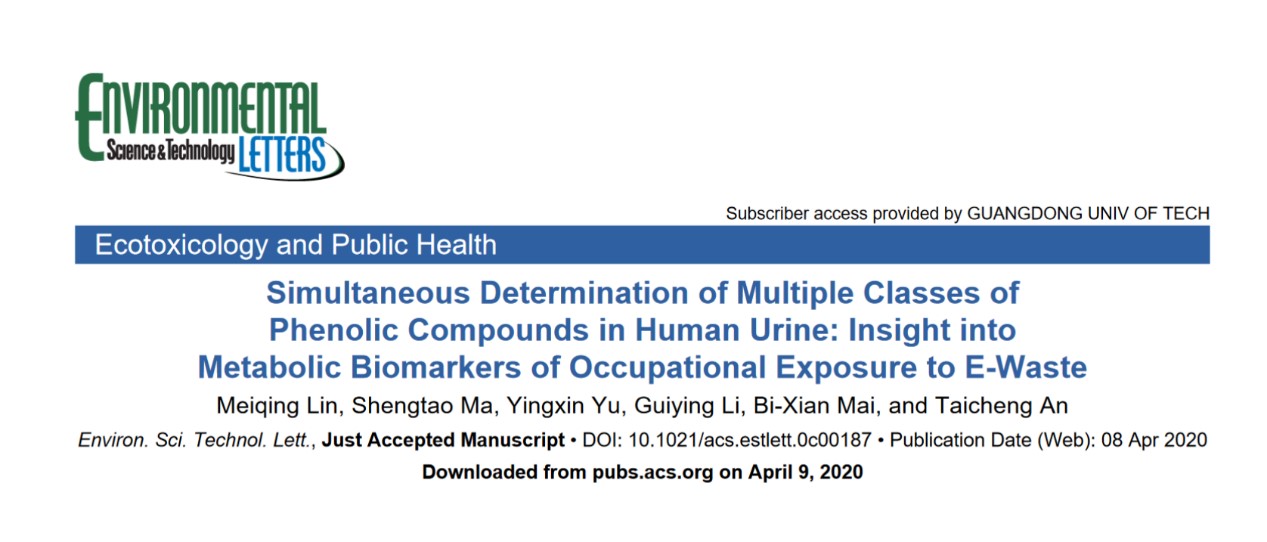近日,广东工业大学环境健康与污染控制研究院、环境科学与工程学院林美卿博士生等在电子垃圾拆解人群多种污染物暴露的潜在生物标志物识别方面取得最新研究进展,研究成果以“Simultaneous Determination of Multiple Classes of Phenolic Compounds in Human Urine: Insight into Metabolic Biomarkers of Occupational Exposure to E-Waste”为题发表在《Environmental science & technology letters》杂志上。

该工作建立了尿液中多种酚类化合物同时分析的方法。在HPLC-MS/MS分析中,我们发现乙酸铵是成功分离溴酚同分异构体色谱峰的关键流动相添加剂。尿液样品通过Oasis® HLB固相萃取提取目标化合物,当体系pH为2、洗脱剂为体积比1:1的甲醇与二氯甲烷混合溶剂时萃取效果最佳。经过初步验证,该方法在样品分析时能获得很好的回收率和精确度。应用该方法,首次在人体尿液样品中检出3,4-diBRP、2,4,5-triBRP、2,3,4,6-tetraBRP和2’-OH-BDE-28。其中,3,4-diBRP、2,3,4,6-tetraBRP和2’-OH-BDE-28仅在电子垃圾拆解工人尿液样品中检出,可作为电子垃圾拆解暴露的生物标志物。该研究可为人群多污染物复合暴露分析以及潜在的溴代阻燃剂酚类代谢物的识别提供新的技术思路。 该杂志属于我校TOP 1 类国际高水平学术期刊,本论文是我们广东工业大学环境学科发表在该杂志上的第一篇学术论文!
论文网址
https://pubs.acs.org/doi/pdf/10.1021/acs.estlett.0c00187
论文英文摘要
ABSTRACT
A new method using solid-phase extraction (SPE) and high-performance liquid chromatography coupled with triple quadrupole mass spectrometry (HPLC-MS/MS) was established for simultaneously analyzing 35 types of phenolic compounds in human urine samples, including 12 hydroxyl polycyclic aromatic hydrocarbons (OH-PAHs), 16 brominated phenols (BRPs), 5 hydroxyl polybrominated diphenyl ethers (OH-PBDEs), triclosan and tetrabromobisphenol A (TBBPA). The presence of NH4Ac in mobile phase played a crucial role in achieving good separation of isomers in HPLC-MS/MS analysis. The efficient SPE condition was obtained at pH=2 with mixture eluent of methanol and dichloromethane. The recoveries of all analytes were 64.5%−143%, 56.2%−135% and 52.5%−123% for low, medium and high spiked levels in urine matrix, respectively, with less than 20% of RSDs of four of repetitive measurements. Moreover, the method was successfully applied to screen the potential urinary biomarker for population exposure to multi-pollutants from e-waste recycling area, and 3,4-diBRP, 2,4,5-triBRP, 2,3,4,6-tetraBRP and 2’-OH-BDE-28 were firstly tentatively detected in human urine. Especially, 3,4-diBRP, 2,3,4,6-tetraBRP and 2’-OH-BDE-28 were only detected in urine samples from e-waste dismantling workers, which should be considered as the urinary biomarkers for occupational exposure. Finally, this developed method will support a more comprehensive health risk assessment for human exposure to multi-pollutants.